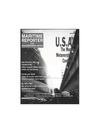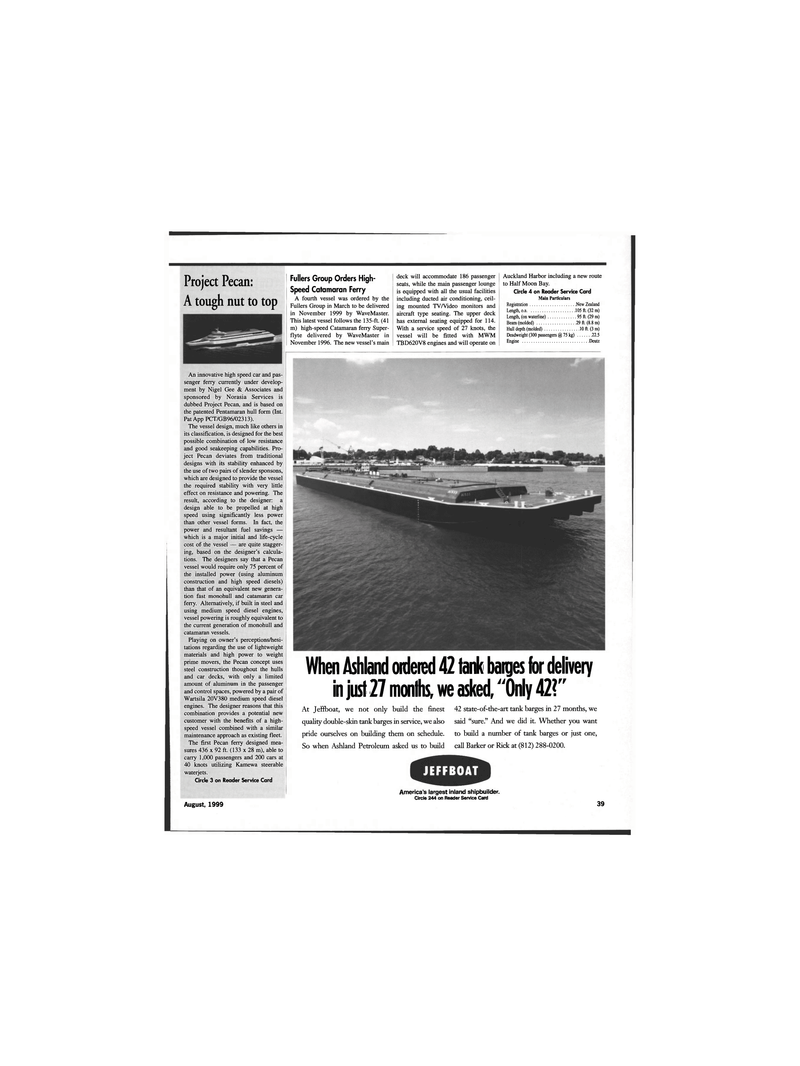
Page 39: of Maritime Reporter Magazine (August 1999)
Read this page in Pdf, Flash or Html5 edition of August 1999 Maritime Reporter Magazine
Project Pecan:
A tough nut to top
Fullers Group Orders High-
Speed Catamaran Ferry
A fourth vessel was ordered by the
Fullers Group in March to be delivered in November 1999 by WaveMaster.
This latest vessel follows the 135-ft. (41 m) high-speed Catamaran ferry Super- flyte delivered by WaveMaster in
November 1996. The new vessel's main deck will accommodate 186 passenger seats, while the main passenger lounge is equipped with all the usual facilities including ducted air conditioning, ceil- ing mounted TV/Video monitors and aircraft type seating. The upper deck has external seating equipped for 114.
With a service speed of 27 knots, the vessel will be fitted with MWM
TBD620V8 engines and will operate on
Auckland Harbor including a new route to Half Moon Bay.
Circle 4 on Reader Service Card
Main Particulars
Registration New Zealand
Length, o.a 105 ft. (32 m)
Length, (on waterline) 95 ft. (29 m)
Beam (molded) 29 ft. (8.8 m)
Hull depth (molded) 10 ft. (3 m)
Deadweight (300 passengers @ 75 kg) 22.5
Engine Deutz
An innovative high speed car and pas- senger ferry currently under develop- ment by Nigel Gee & Associates and sponsored by Norasia Services is dubbed Project Pecan, and is based on the patented Pentamaran hull form (Int.
Pat App PCT/GB96/02313).
The vessel design, much like others in its classification, is designed for the best possible combination of low resistance and good seakeeping capabilities. Pro- ject Pecan deviates from traditional designs with its stability enhanced by the use of two pairs of slender sponsons, which are designed to provide the vessel the required stability with very little effect on resistance and powering. The result, according to the designer: a design able to be propelled at high speed using significantly less power than other vessel forms. In fact, the power and resultant fuel savings — which is a major initial and life-cycle cost of the vessel — are quite stagger- ing, based on the designer's calcula- tions. The designers say that a Pecan vessel would require only 75 percent of the installed power (using aluminum construction and high speed diesels) than that of an equivalent new genera- tion fast monohull and catamaran car ferry. Alternatively, if built in steel and using medium speed diesel engines, vessel powering is roughly equivalent to the current generation of monohull and catamaran vessels.
Playing on owner's perceptions/hesi- tations regarding the use of lightweight materials and high power to weight prime movers, the Pecan concept uses steel construction thoughout the hulls and car decks, with only a limited amount of aluminum in the passenger and control spaces, powered by a pair of
Wartsila 20V380 medium speed diesel engines. The designer reasons that this combination provides a potential new customer with the benefits of a high- speed vessel combined with a similar maintenance approach as existing fleet.
The first Pecan ferry designed mea- sures 436 x 92 ft. (133 x 28 m), able to carry 1,000 passengers and 200 cars at 40 knots utilizing Kamewa steerable waterjets.
Circle 3 on Reader Service Card
August, 1999
When Ashland ordered 42 tank barges for delivery in just 27 months, we asked, "Only 42?"
At Jeffboat, we not only build the finest 42 state-of-the-art tank barges in 27 months, we quality double-skin tank barges in service, we also said "sure." And we did it. Whether you want pride ourselves on building them on schedule. to build a number of tank barges or just one,
So when Ashland Petroleum asked us to build call Barker or Rick at (812) 288-0200.
America's largest inland shipbuilder.
Circle 244 on Reader Service Card 39

 38
38

 40
40
